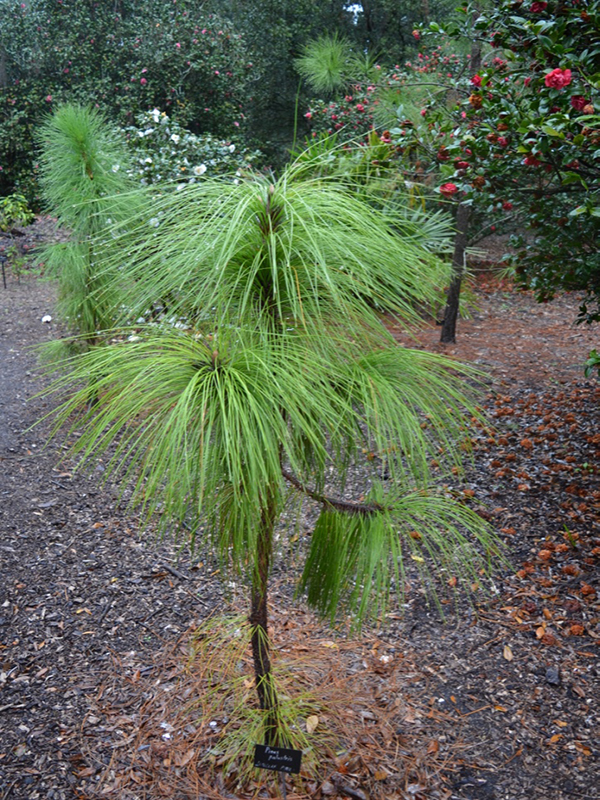
Woody > Pinus > Pinus palustris > Pinus palustris
Pinus palustris
Longleaf Pine, George Pine
Origin: South-eastern region of the United States of America.

"
My first thought when I saw the tree was its ability to make you stand back and admire the beauty of it; height, branch and needle length. The tree is very large, what makes it stand out is the sparseness. The tree is so big in its full form that you expect it to be full of needles and branches, but the branches only start halfway up the tree and there are only needles forming on the outer regions of them. This effect creates somewhat of a tall canopy that makes it interesting to walk underneath. I found it engaging that the tree starts off as a scrubby shrub and then continues to mature into a tree that can take up to 150 years to reach its full size and live up to 500 years. The tree is also known as the Georgia Pine and is mentioned in numerous southern songs because of its beauty and popularity.
Michael Pascoe, NDP., ODH., CLT., MSc. (Plant Conservation)
"
| Family |
| Pinaceae |
| Genus |
| Pinus |
| Species |
| palustris |
| Category |
| Woody |
| Type |
| Tree (evergreen) |
| USDA Hardiness Zone |
| 7 - 9 |
| Canadian Hardiness Zone |
| 2a - 6b |
| RHS Hardiness Zone |
| H4 |
| Temperature (°C) |
| -8 |
| Temperature (°F) |
| 17 |
| Height |
| 30 - 35 m |
| Spread |
| 5 - 10 m |
| General Description |
| Is a coniferous, tall tree with very long needles. The branches are sparse and do not show on the tree until approximately halfway up. |
| Landscape |
| The tree is not only crucial to a healthy ecosystem, but also commercially valuable, making it a valuable landscape species. The large forests containing these trees are endangered, making this species a popular planting for conserving the landscape. |
| Cultivation |
| The tree will survive in a range of habitats, preferably acidic soils. They are shade intolerant and require lots of sunlight to grow. The tree is fire-resistant. |
| Shape |
| In maturity it is tall, straight and very sparse. |
| Growth |
| Slow |
| ID Characteristic |
| The tree naturally prunes its lower branches and inner needles causing it to look very sparse. |
| Habitat |
| The tree grows in warm, wet temperature climates with mild winters. Most popular in Georgia in the south-eastern United States. |
| Bark/Stem Description |
| It is thick, scaly and resistant to fire. The colour of the bark ranges from red to brown. |
| Flower/Leaf Bud Description |
| The bud is large, but is hard to see due to the size of the needles surrounding it, it is yellow in colour. |
| Leaf Description |
| Needles can grow up to 45 cm long, are dark green and occur in bundles of three. |
| Flower Description |
| The male pollen cone begins to form in July. Pollination occurs with the 3-8 cm long male cone the following spring. |
| Fruit Description |
| The female cones take twenty months to mature after pollination. They are also a yellow-brown colour but are much larger than the male cones, 15-25 cm long, 5-7 cm broad. |
| Texture Description |
| The tree is a rough texture with scaly bark and cones. The needles are long, making them softer than most other pine trees. |
| Notable Specimens |
| Bok Tower Gardens, Lake Wales, Florida, United States of America. Harry P. Leu Gardens, Orlando, Florida, United States of America. |
| Propagation |
| The seeds require two months of cold stratification before being sown at around 20°C. Germination will start two months after that. The seedlings will tolerate infertile and acidic soils, but will thrive with good drainage and moisture. They should be grown in containers for two years before planting out. |
| Ethnobotanical Uses (Disclaimer) |
| One of the most popular trees for South-Eastern Americans to use in the past, because of its population, size, hardiness and quality of timber. The tree was used in construction and furniture production. The resin from the tree was used to make a thick tar which worked well as waterproofing for ships. The tree was over harvested to the point that the species became threatened. Not realizing the endangerment, the people of the past planted faster-growing pines for more of a short-term economic interest succumbing to the near extinction of the longleaf pine. |
